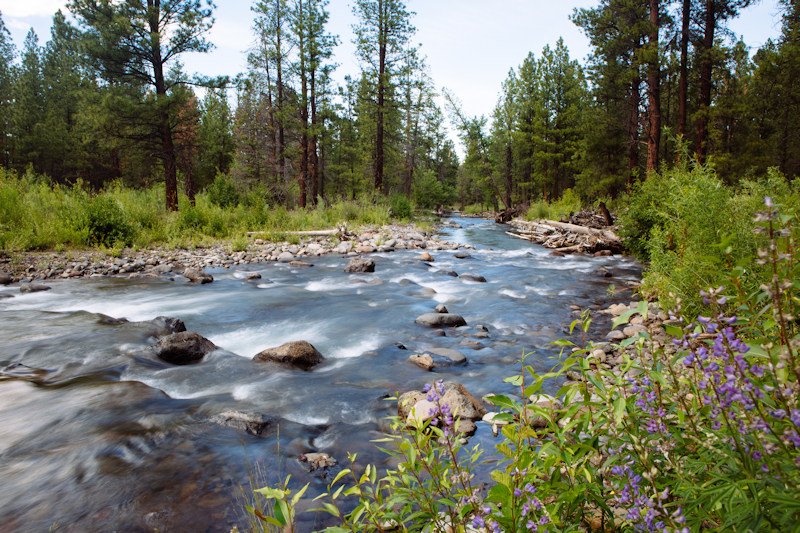Coors Seltzer funding will help keep Whychus Creek flowing in late summer

BEND, Ore. (KTVZ) -- The Deschutes River Conservancy said Thursday it is working with funding from Coors Seltzer to further incentivize water leasing in Whychus Creek, a reach that used to run dry two of every three years.
Three Sisters Irrigation District diverts flows from the creek for area irrigators. DRC and TSID have worked steadily over the past 20 years to bring back year-round flows through water transfers and piping to permanently protect up to 34 cubic feet per second (cfs) of water rights in-stream.
DRC’s in-stream leasing program augments these flows further. Continuing to improve conditions in the stream is critical for migrating and native fish, including redband trout, steelhead and bull trout.
Coors Seltzer has partnered with Change the Course to protect and restore the waterways that provide clean water to wildlife and millions of people in communities across the country. With every 12-pack of Coors Seltzer sold, the partnership is restoring 500 gallons of water through support of projects like Whychus Creek leasing.
In-stream leasing is a state program that enables irrigators to lease unused water back in-stream. These leases satisfy state water use requirements for the farmer and improve ecological flows in-stream.
DRC and TSID have a long-running in-stream leasing program, but funding from Coors Seltzer will provide additional incentive to increase participation and to launch the dry-year program that has been in development for over 5 years. This bump in flows in Whychus Creek will occur in mid and late summer - when flows drop off dramatically and when stream temperature in the creek is of highest concern.
Coors Seltzer funding will cover a 2-year period for DRC to lease between 1,000 and 1,600 acre-feet. This range takes into account the variability of streamflow, which is dependent on snowpack, and will also allow for an increase in leasing participation. TSID will lease up to 8 cubic feet per second (5,590 gallons per minute), up to a 25% increase over current leasing.
“The Coors Seltzer funding has allowed the DRC to enhance its ability to protect flows in Whychus Creek,” said Gen Hubert, program manager for the Deschutes River Conservancy. “This, in combination with the finalization of the Habitat Conservation Plan (HCP) and goals over time to meet temperature standards in lower Whychus Creek, has provided an incentive to kick-start a program that TSID and DRC staff have been discussing for a few years now.”
The DRC said it is optimistic that two years of Coors Seltzer funding to help launch this program will give momentum to a stronger rotational leasing program in Whychus Creek. Leasing on Whychus Creek is already up 150 acres this year as a result of this new incentive.
“This is a good start to the 2-year agreement,” Hubert adds, “and it’s gratifying to partner in a funding program that promotes sustainability, while helping DRC develop a stronger program with TSID to meet HCP conservation goals.”
“TSID has been working in partnership with the DRC for over 20 years to restore flows to Whychus Creek while also improving deliveries to our farms,” said Marc Thalacker, manager of the Three Sisters Irrigation District. “Since 2006, we’ve been involved with the Deschutes Partnership (DRC, Deschutes Land Trust, Upper Deschutes Watershed Council) in support of a comprehensive restoration strategy that guides habitat restoration for steelhead reintroduction. We are committed to continue work in this partnership to restore flows and habitat in Whychus Creek.”
# # #
About the Deschutes River Conservancy: Twenty-five years ago, the Deschutes River Conservancy (DRC) formed with a mission to restore streamflow and improve water quality in the Deschutes River Basin. The DRC specializes in programs and projects that employ voluntary, market-based incentives to restore flows. The DRC is non-litigious and serves as leaders and facilitators of basin-wide water management conversations. The board is comprised of key private and public stakeholders in the basin. The organization has worked with eight irrigation districts and over 250 landowners to restore over 208 cubic feet per second of streamflow to the basin’s rivers and streams.
Learn more at www.deschutesriver.org
About Change the Course: Change the Course, a campaign of the Bonneville Environmental Foundation, is a first-of-its-kind initiative that brings together the public, corporations and on-the-ground conservation organizations to raise awareness about freshwater issues, reduce water footprints and directly support water restoration projects. Change the Course is the leading national corporate water restoration and engagement campaign. The initiative has received contributions from over 65 corporate sponsors; supported over 120 water projects across 21 U.S. states, Canada and Mexico; and restored over 28 billion gallons of water. Learn more at www.changethecourse.us
About Three Sisters Irrigation District: Three Sisters Irrigation District provides irrigation water to 7,572 acres of irrigated farmland in the Sisters area and to the north and northwest. TSID, first incorporated in 1891, was formed to construct ditches, canals and flumes to provide irrigation. The original canal took 16 years to construct, cutting through rock and using mules and plows. The district has consistently worked to improve how it diverts, manages and uses water. The district began piping private laterals in 1998 moving on to larger ditches in 2005 and is now almost completely piped. In 2011 TSID completed reconstruction of their diversion to allow natural fish passage. All of this work has taken Whychus Creek from dry during the summer to flowing year-round while improving deliveries to farms. Learn more at www.tsidweb.org



